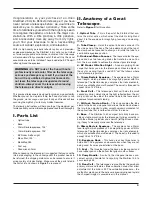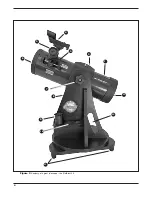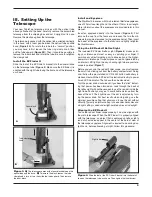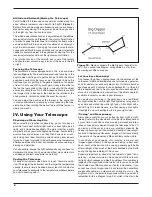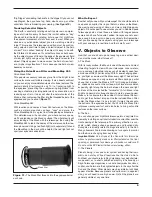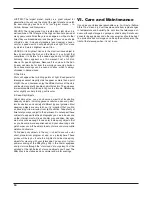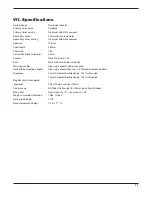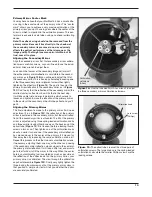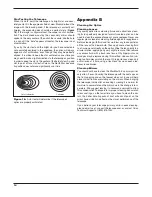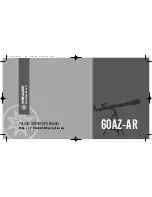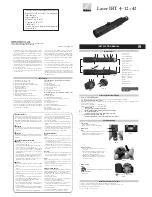
9
“Big Dipper” connecting the handle to the “dipper”. If you cannot
see Megrez, then you have fog, haze, clouds, smog, or other
conditions that are hindering your viewing. (See
Figure 10
.)
Tracking Celestial Objects
The Earth is constantly rotating about its polar axis, complet-
ing one full rotation every 24 hours; this is what defines a “day”.
We do not feel the Earth rotating, but we see it at night from
the apparent movement of stars from east to west. When you
observe any astronomical object, you are watching a moving
target. This means the telescope’s position must be continu-
ously adjusted over time to keep a celestial object in the field
of view. This is called “tracking” the object. It’s easy to do with
the StarBlast 4.5 because of its smooth motions on both axes.
As the object moves off toward the edge of the eyepiece’s field
of view, just lightly nudge or tug the telescope to re-center the
object. Objects appear to move across the field of view fast-
er at higher magnifications. This is because the field of view
becomes narrower.
Using the Orion Moon Filter and MoonMap 260
Orion Moon Filter
This popular accessory reduces glare from the bright lunar
surface for more comfortable viewing. It also boosts contrast
so you can enjoy more-detailed views of surface features. The
neutral density filter transmits only 13% of incoming light to
the eyepiece, preventing the overpowering brightness from
washing out details, providing better clarity and resolution, and
reducing eye strain. It does not alter the natural color of the
Moon, either. Just screw the filter into the threaded barrel of the
eyepiece and you’re all set (
Figure 11
).
Orion MoonMap 260
With locations and names of over 260 features on the Moon
such as craters, mountains, valleys, "seas" and more, the
Orion MoonMap 260 is a great tool for beginning astronomers.
This detailed map will even show you where various space-
craft have landed on the Moon's surface! The whole family will
enjoy looking at the Moon with the telescope, then using the
MoonMap 260 to learn the names of the craters and other fea-
tures observed. Using a red flashlight (sold separately) to read
the MoonMap in the dark will be helpful; the red light will not
spoil your eyes’ dark adaptation.
What to Expect
So what will you see with your telescope? You should be able to
see bands on Jupiter, the rings of Saturn, craters on the Moon,
the waxing and waning of Venus, and many bright deep-sky
objects. Do not expect to see color as you do in Hubble Space
Telescope photos, since those are taken with long-exposure
cameras and have “false color” added. Our eyes are not sensi-
tive enough to see color in deep-sky objects. But remember
that you are seeing these objects using your own telescope
with your own eyes, in real time. And that’s pretty cool!
V. Objects to Observe
Now that you are all set up and ready to go, one critical deci-
sion must be made: what to look at?
A. The Moon
With its rocky surface, the Moon is one of the easiest and most
interesting targets to view with your telescope. Lunar craters,
maria, and even mountain ranges can all be clearly seen from
a distance of 238,000 miles away! With its ever-changing phas-
es, you’ll get a new view of the Moon every night. The best time
to observe our one and only natural satellite is during a partial
phase, that is, when the Moon is NOT full. During partial phas-
es, shadows are cast on the surface, which reveal more detail,
especially right along the border between the dark and light
portions of the disk (called the “terminator”). A full Moon is too
bright and devoid of surface shadows to yield a pleasing view.
Make sure to observe the Moon when it is well above the hori-
zon to get the sharpest images. Use the included Moon Filter
to dim the Moon when it is very bright. It simply threads onto
the bottom of the eyepiece barrel. You’ll find that a Moon filter
improves viewing comfort, and also helps to bring out subtle
features on the lunar surface.
B. The Sun
You can change your nighttime telescope into a daytime Sun
viewer by installing an optional full-aperture solar filter over the
front opening of the telescope. The primary attraction is sun-
spots, which change shape, appearance, and location daily.
Sunspots are directly related to magnetic activity in the Sun.
Many observers like to make drawings of sunspots to monitor
how the Sun is changing from day to day.
Important Note:
Do not look at the Sun with this telescope
without a professionally made solar filter installed on the front
opening, or permanent eye damage or blindness could result!
Do not use the EZ Finder II when solar viewing, either.
C. The Planets
Planets, being in our own solar system and having their own
orbits, do not stay at “fixed” locations like the stars do. So to
find them you should refer to Sky Calendar at our website (tele-
scope.com), or to charts published monthly in Astronomy or
Sky & Telescope magazines, or on astronomy websites. Venus,
Jupiter, and Saturn are the brightest objects in the sky after the
Sun and the Moon. Other planets may be visible but will likely
appear star-like. Because planets are quite small in apparent
size, you will need to use high power. Not all the planets are
generally visible at any one time.
Figure 11.
The Moon filter threads into the eyepiece barrel
as shown.
Moon filter



